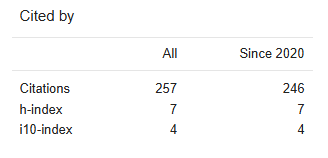Paper Details


Call For Papers
Volume 06, Issue 12
Frequency: 12 Issue per year
Paper Submission: Throughout the Month
Acceptance Notification: Within 2 days
Areas Covered: Multidisciplinary
Accepted Language: Multiple Languages
Journal Type: Online (e-Journal)
Announcement

Publish books with ISBN Number
- Edited Book
- Text Book
- Ph.D Thesis
- Conference Proceedings
ISSN Number:
2582-8568
Journal DOI No:
03.2021-11278686
Title:
Transforming Tribal Education: Overcoming Challenges and Embracing Inclusive Practices
Authors:
Cite this Article:
,
Transforming Tribal Education: Overcoming Challenges and Embracing Inclusive Practices, International Research Journal of Humanities and Interdisciplinary Studies (www.irjhis.com), ISSN : 2582-8568, Volume: 4, Issue: 11, Year: November 2023, Page No : 50-54,
Available at : http://irjhis.com/paper/IRJHIS2311009.pdf
Abstract:
Tribal education faces a number of challenges, including a lack of resources, qualified teachers, and culturally relevant curriculum. These challenges can lead to low student achievement and high dropout rates. However, there are a number of strategies that can be used to overcome these challenges and create more inclusive and equitable learning environments for tribal students. One important strategy is to increase funding for tribal schools. This will allow schools to hire more qualified teachers, purchase new materials, and provide students with the support they need to succeed. Additionally, it is important to develop culturally relevant curriculum that reflects the history, language, and traditions of tribal students. This will help students to feel connected to their culture and make learning more meaningful. Another important strategy is to involve tribal communities in the education of their children. This can be done by creating school boards that include tribal members, developing partnerships between schools and tribal organizations, and incorporating tribal culture and traditions into the school curriculum. When tribal communities are involved in the education of their children, they are more likely to support and invest in their children's education. Finally, it is important to create a supportive and inclusive school climate for tribal students. This means creating a school environment where all students feel safe, respected, and valued. It also means providing students with opportunities to learn about different cultures and to develop their own cultural identity. By implementing these strategies, we can create more inclusive and equitable learning environments for tribal students. This will help to close the achievement gap and ensure that all students have the opportunity to succeed.
Keywords:
Tribal Education, Inclusive Education, Challenges, Strategies
Publication Details:
Published Paper ID: IRJHIS2311009
Registration ID: 21209
Published In: Volume: 4, Issue: 11, Year: November 2023
Page No: 50-54
ISSN Number: 2582-8568
Download Full Paper: Click Here
Article Preview:





